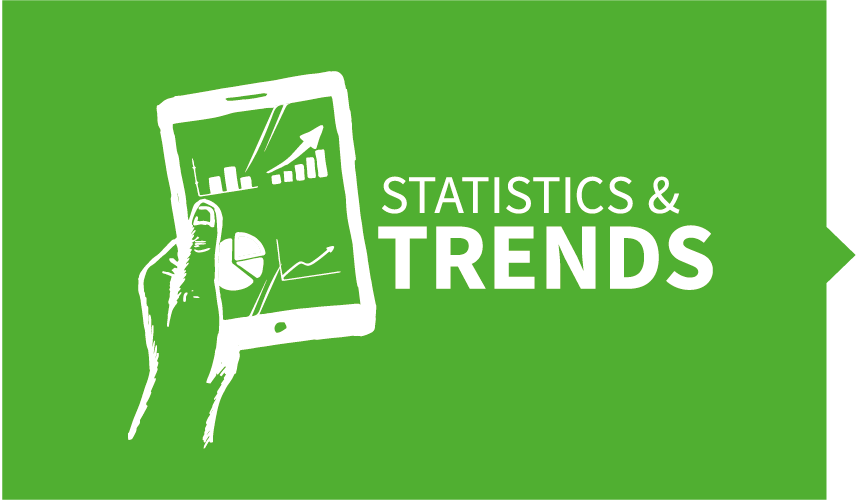RECYCLING
FOR A GREEN FUTURE

EU and Europe
The amount of WEEE collected in the EU is currently around 5.1 million tonnes per year. Across Europe, only about 42.5% of the theoretically available WEEE is recycled in a correct and traceable manner. There is a lot of catching up to do in southern and eastern Europe, whereas the Nordic countries have the highest collection rate (59%) in the world. The EU WEEE Directive states that the minimum collection rate to be achieved annually by a member state shall be 85% of e-waste generated on the territory of a member state, which indicates that collection and recycling must increase even further. The difference to the theoretically available quantity is partly due to residual waste processing – here, too, only part is recycled correctly and as far as possible. Not inconsiderable quantities leave the European Economic Area as (functional as well as dysfunctional) used goods.
America
In North and South America, 13.1 million tonnes of e-waste were generated in 2019 and thereof 1.2 million tonnes were collected and demonstrably recycled. This puts America at a collection rate of 9.4%, with the richer countries (USA and Canada) generating 20.9 kg per inhabitant. The USA and Canada have state and provincial laws for the disposal of e-waste and most available data. Large quantities of used electrical appliances are exported from the USA to Central and South American countries such as Mexico, Venezuela and Paraguay, but mainly to Asian countries. The rest of the continent is well developed compared to the rest of the world with 7 kg of generated e-waste per inhabitant. South America, however, has few guidelines for the control of e-waste.
Mexico collects the most e-waste in Latin America with a collection rate of 36%. The remaining countries, however, have a collection rate of less than 3%. The biggest challenge for the sustainable disposal of e-waste in Latin America is the acceleration of all legislative processes regarding collection and recycling.
Asia
In Asia, the total e-waste generation in 2019 was 24.9 million tonnes, or 5.6 kg of e-waste per inhabitant. China generates the highest amount of e-waste both in Asia and in the world (10.1 million tonnes). An average of 72% of the population in Asia is covered by national legislation on e-waste, as the most populous countries in Asia (China and India) have e-waste regulations, however the average collection rate is only 11.7%. In East Asia, the official collection rate is 20%, while in other sub-regions, such as Central and South Asia, it is 0-5%.
In China, the informal sector remains the leader in the collection and recycling of WEEE. This very often leads to harmful environmental and health effects from improper and unsafe treatment of WEEE. Other countries have introduced advanced regulation of e-waste, such as Japan and South Korea.
India plays an important role due to its large population, but the country also imports from developed countries. India’s electronics industry is one of the fastest growing in the world. However, there are informal recycling processes carried out by over 1 million people who are unaware of the dangers of manual recycling.
Africa
The amount of e-waste generated in 2019 in Africa was 2.9 million tons, of which only 50 – 85% is local generated, the rest consists of illegal transport from developed countries in America and Europe, as well as China. However, little is known about the documented amount of collected and recycled e-waste. Only a few countries have e-waste specific regulations and laws.
Recycling activities are dominated by poorly equipped informal sectors associated with inefficient resource recovery and pollution.
Governments in many African countries are showing increasing concern and interest in solving the e-waste problem. In this context, many countries currently receive advisory, technical and financial support from several UN agencies, other development agencies, the private sector and in particular the Alliance of Original Equipment Manufacturers in Africa.
Oceania
In Oceania, the total e-waste generation in 2019 was 0.7 million tonnes, of which only 8.8% was collected and recycled. The country with the highest absolute e-waste generation is Australia (0.55 million tonnes). In 2019, Australia and New Zealand generated 21.3 kg per inhabitant. Only the Australian government implemented a recycling program in 2011. Official data show that still only 9% of the electrical waste generated in Australia and New Zealand is documented as collected and recycled. In the rest of Oceania, the official collection rate is documented almost 0%. In the countries of the Pacific Islands, the disposal and recycling of WEEE is predominantly informal.
The Pacific Island sub-region, consisting of 22 countries and territories, faces particular challenges due to its geographical distribution. The limited availability of suitable land on small islands for the construction of landfills, the remoteness and relatively small population and limited institutional and personnel capacities, as well as changing weather conditions and rising sea levels are among the most important challenges facing the Pacific islands.
Sources:
Eurostat (Statistical Department of the European Union): https://ec.europa.eu/eurostat/home
Forti V., Baldé C.P., Kuehr R., Bel G. The Global E-waste Monitor 2020: Quantities, flows and the circular economy potential. United Nations University (UNU)/United Nations Institute for Training and Research (UNITAR) – co-hosted SCYCLE Programme, International Telecommunication Union (ITU) & International Solid Waste Association (ISWA), Bonn/Geneva/Rotterdam.




